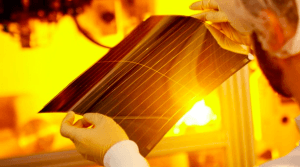
Heliatek says its R&D teams achieved the new record using a multi-junction cell and that the measurement was independently confirmed by Fraunhofer CSP’s solar testing facility. While traditional silicon cells have achieved higher levels of conversion efficiency, organic cells are also pursued because they can be produced more cheaply and are also more flexible.
In fact, the firm claims that “the excellent low light and high temperature behavior of the organic semiconductor” in the new cells makes them equivalent to the electricity generation capability of conventional solar cells with 16-17 percent efficiency under real world conditions.
“This success is based on our chemical research for new organic absorber materials,” said Heliatek’s Dr. Martin Pfeiffer.
The new world-record cell combines three different absorbers, each dedicated to efficiently converting green, red or near-infrared light of a certain wavelength to electricity.
The firm hopes to use the new technology in its ultralight and flexible “HeliaFilm” line of cells that are produced in a roll-to-roll manufacturing process and designed to add solar power generation to buildings.
